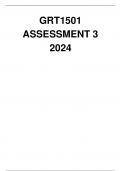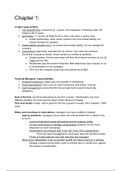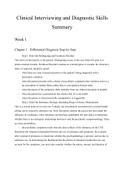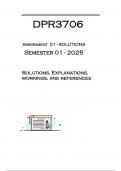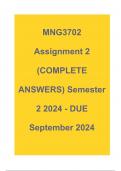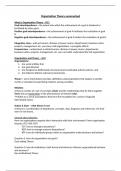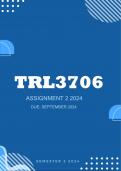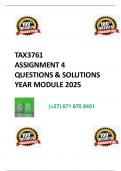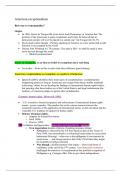Introduction to Organization Development
Lecture 1
What is organization development?
The LONG-RANGE EFFORT to improve:
1) an organization’s/system’s problem-solving capabilities and
2) its abilities to cope with changes in the external environment
with the help of external or internal behavioral-scientist consultants or change agents, as they are
sometimes called
Looks at the complexity from a SYSTEMIC PERSPECTIVE
Aims at deep-level changes (e.g. beliefs, behaviors...)
Planned change
Open Systems
Organizations continually interact with their environments
Feed-back from the environment helps the system to adapt
Changing the culture
Culture is a system of shared values and beliefs that interact with an organization’s people, structure
and systems to produce behavioral norms;
- “the way we do things around here”
It includes:
- artifacts: clothes, language, behaviors;
- norms and values: unwritten rules;
- deep assumptions;
Lecture 2: Understanding OD Process, Resistance to change and
interventions
Police example see slides
Q1: They actual performance was very few female at top. 25 percent is what they want to achieve.
They apply intervention and change happens
Q4: Stereotypes
Q5: Creating new oppertunities,
,Diagnosis: is a systematic approach to understanding and
describing the present state of the organization. The purpose of
the diagnostic phase is:
- to gather information to specify the exact nature of the
problem requiring solution,
- -to identify the underlying causal forces,
- and to provide a basis for selecting effective change
strategies and techniques.
Diagnosis is a cyclical process that involves data gathering,
interpretations, and identification of problem areas and possible
action programs
Data collection
• Step 1. define objectives of the change program (session of interviews with key members of the
organization)
• Step 2. selection of key factors (central variables involved)
• Step 3. selection of data gathering method (e.g. secondary data, survey, sociometric approach,
direct observation, interviewing) (In OD Process: triangulation, use multiple approaches)
Diagnostic models (IMPORTANT)
1. Analytical model (difference-integration model): relations among departments.
-Interventions: structural changes, so new teams that combine goals
2.The Sociotechnical Systems Model (Eric Trist Tavistock Institute)
A social system consisting of the network of interpersonal relationships and a technological
system consisting of the task, activities, and tools used to accomplish the organization’s
purpose.
These two systems—the social system and the technological system—are interrelated and
interdependent. The diagnosis determines how they interrelate, with emphasis on the
feedback or lack of feedback between the various subsystems.
Organization runs well if the social system works/aligns well with the technological system
3. The Force-Field Analysis Model (Kurt Lewin, Tavistock)
Organizational behavior is a dynamic balance of forces working
in opposite directions
The forces acting to keep the organization stable are called
restraining forces; they put pressure on the organization not to
change. Opposite forces, called driving forces, put pressure on
the organization to change. If the forces for change and the
forces against change are equal, the result is equilibrium, and
the organization remains stable
, Lifecycle of resistance
Phase 1 In the first phase, there are only a few people who see the need for change and take
reform seriously.
Phase 2 As the movement for change begins to grow, the forces for and against it become
identifiable. The change is discussed and is more thoroughly understood by more of the
organization’s members.
Phase 3 In this phase there is a direct conflict and showdown between the forces for and
against the change. This phase will probably mean life or death to the change effort, because
the exponents of the change often underestimate the strength of their opponents
Phase 4 There is still a possibility that the resisters will mobilize enough support to shift the
balance of power. Wisdom is necessary in dealing with the overt opposition and also with the
sizable element who are not openly opposed to the change but also not convinced of its
benefits.
Phase 5 In the last phase, the resisters to the change are as few and as alienated as the
advocates were in the first phase. the actual conflict is usually more subtle and may only
surface in small verbal disagreements, questions, reluctance, and so forth
DRIVING FORCES (for change)
• Dissatisfaction with the Present Situation
• External Pressures Toward Change
• Momentum Toward Change
• Motivation by Management
Lecture 3: OD Strategy and Improving Excellence in Individuals
Apple went from Product-based organization to a Functional-based organization. They still remained
this form even when they became 40 times as large.
Organizational theory: make the case that as firms grow large and complex, they must shift from a
functional to a multidivisional structure to align accountability and control and prevent the
congestion that occurs when countless decisions flow up the org chart to the very top.
Lecture 1
What is organization development?
The LONG-RANGE EFFORT to improve:
1) an organization’s/system’s problem-solving capabilities and
2) its abilities to cope with changes in the external environment
with the help of external or internal behavioral-scientist consultants or change agents, as they are
sometimes called
Looks at the complexity from a SYSTEMIC PERSPECTIVE
Aims at deep-level changes (e.g. beliefs, behaviors...)
Planned change
Open Systems
Organizations continually interact with their environments
Feed-back from the environment helps the system to adapt
Changing the culture
Culture is a system of shared values and beliefs that interact with an organization’s people, structure
and systems to produce behavioral norms;
- “the way we do things around here”
It includes:
- artifacts: clothes, language, behaviors;
- norms and values: unwritten rules;
- deep assumptions;
Lecture 2: Understanding OD Process, Resistance to change and
interventions
Police example see slides
Q1: They actual performance was very few female at top. 25 percent is what they want to achieve.
They apply intervention and change happens
Q4: Stereotypes
Q5: Creating new oppertunities,
,Diagnosis: is a systematic approach to understanding and
describing the present state of the organization. The purpose of
the diagnostic phase is:
- to gather information to specify the exact nature of the
problem requiring solution,
- -to identify the underlying causal forces,
- and to provide a basis for selecting effective change
strategies and techniques.
Diagnosis is a cyclical process that involves data gathering,
interpretations, and identification of problem areas and possible
action programs
Data collection
• Step 1. define objectives of the change program (session of interviews with key members of the
organization)
• Step 2. selection of key factors (central variables involved)
• Step 3. selection of data gathering method (e.g. secondary data, survey, sociometric approach,
direct observation, interviewing) (In OD Process: triangulation, use multiple approaches)
Diagnostic models (IMPORTANT)
1. Analytical model (difference-integration model): relations among departments.
-Interventions: structural changes, so new teams that combine goals
2.The Sociotechnical Systems Model (Eric Trist Tavistock Institute)
A social system consisting of the network of interpersonal relationships and a technological
system consisting of the task, activities, and tools used to accomplish the organization’s
purpose.
These two systems—the social system and the technological system—are interrelated and
interdependent. The diagnosis determines how they interrelate, with emphasis on the
feedback or lack of feedback between the various subsystems.
Organization runs well if the social system works/aligns well with the technological system
3. The Force-Field Analysis Model (Kurt Lewin, Tavistock)
Organizational behavior is a dynamic balance of forces working
in opposite directions
The forces acting to keep the organization stable are called
restraining forces; they put pressure on the organization not to
change. Opposite forces, called driving forces, put pressure on
the organization to change. If the forces for change and the
forces against change are equal, the result is equilibrium, and
the organization remains stable
, Lifecycle of resistance
Phase 1 In the first phase, there are only a few people who see the need for change and take
reform seriously.
Phase 2 As the movement for change begins to grow, the forces for and against it become
identifiable. The change is discussed and is more thoroughly understood by more of the
organization’s members.
Phase 3 In this phase there is a direct conflict and showdown between the forces for and
against the change. This phase will probably mean life or death to the change effort, because
the exponents of the change often underestimate the strength of their opponents
Phase 4 There is still a possibility that the resisters will mobilize enough support to shift the
balance of power. Wisdom is necessary in dealing with the overt opposition and also with the
sizable element who are not openly opposed to the change but also not convinced of its
benefits.
Phase 5 In the last phase, the resisters to the change are as few and as alienated as the
advocates were in the first phase. the actual conflict is usually more subtle and may only
surface in small verbal disagreements, questions, reluctance, and so forth
DRIVING FORCES (for change)
• Dissatisfaction with the Present Situation
• External Pressures Toward Change
• Momentum Toward Change
• Motivation by Management
Lecture 3: OD Strategy and Improving Excellence in Individuals
Apple went from Product-based organization to a Functional-based organization. They still remained
this form even when they became 40 times as large.
Organizational theory: make the case that as firms grow large and complex, they must shift from a
functional to a multidivisional structure to align accountability and control and prevent the
congestion that occurs when countless decisions flow up the org chart to the very top.

